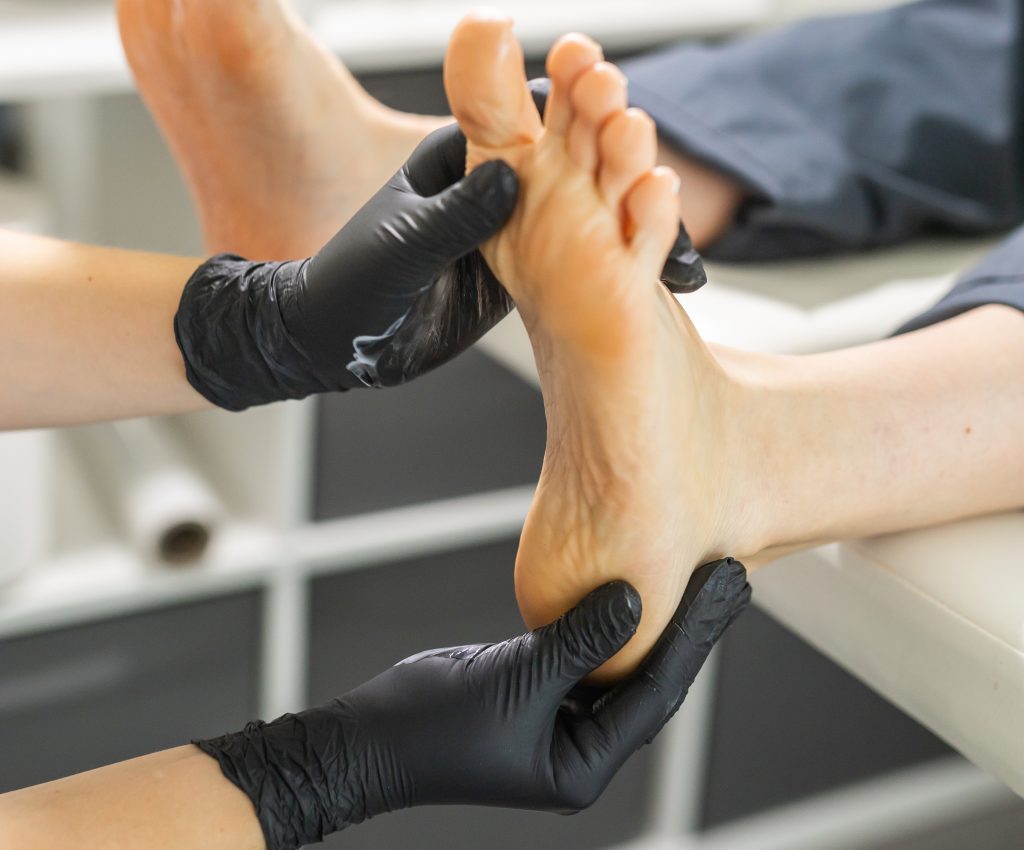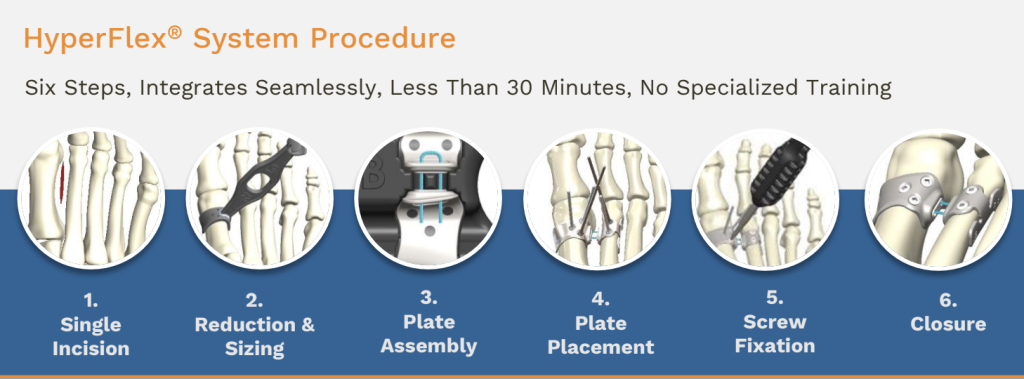
The global podiatry services market size was estimated at $4.53 billion in 2023 and is projected to reach $5.29 billion by 2030, growing at a rate of 2.3% per year. This growth is due partly to the rising prevalence of chronic conditions affecting the feet, such as diabetes and arthritis, significantly increasing the demand for specialized foot care.
In this report, we’ll explore podiatry industry trends for 2026, including AI-driven diagnostics, 3D-printed orthotics, and a shift toward minimally invasive solutions like the groundbreaking HyperFlex® device for bunion treatment.
Podiatry Industry Trends in 2026
Podiatry is entering an era of rapid, tech-driven change. We’re seeing artificial intelligence assisting clinicians, additive manufacturing that custom-fits patients in hours rather than weeks, and an unmistakable shift toward bone preservation and minimally invasive interventions. Here are the key podiatry industry trends to watch in 2026.
| Podiatry Industry Trends 2026 | ||
|---|---|---|
| Trend | What it Means | What We’ll See in 2026 |
| AI-driven diagnostics | Machine learning models, imaging analysis, and triage tools that support diagnosis and risk assessment for diabetic foot, gait pathology, ulcers, and more. | Wider adoption in triage/support roles; pilot clinical use in specialty clinics; regulatory scrutiny for diagnostic use. |
| 3D-printed orthotics | On-demand, patient-specific insoles and braces made via 3D printing, with variable shapes and stiffness levels and faster turnaround times. | Many clinics will offer in-house or local 3D printing services; growing trial evidence of improved comfort and gait metrics. |
| Minimally invasive solutions (e.g., HyperFlex) | Implant-based systems that correct deformity without invasive surgical procedures; faster recovery, preserved bone. | Increased uptake in outpatient settings for mild-to-moderate bunions; newer devices receiving FDA clearance and investment. |
| Remote monitoring & smart insoles | Wearables and sensor-embedded insoles for plantar pressure, ulcer risk, adherence, and telemedicine follow-up. | Integration with health records and AI analytics for chronic care programs, especially for conditions like diabetes. |
AI-Driven Diagnostics
AI tools are increasingly capable of analyzing complex medical images, gait metrics, and sensor data. In podiatry, AI is starting to help doctors by analyzing foot scans, X-rays, and walking patterns. Current research shows that podiatrists are open to using AI as an assistant, but remain cautious about using the technology to diagnose specific conditions.
What We’re Expecting in 2026
Researchers are already using AI to interpret foot images and plantar pressure maps, speeding identification of high-risk diabetic foot ulcers (with 97% accuracy) that benefit from earlier intervention.
Expect AI to routinely appear as a second reader in imaging workflows and as a background analytics layer for smart insoles and gait labs. It certainly won’t replace podiatrists, but it is evolving into a valuable tool that helps provide patients with the best possible standard of care.
3D-Printed Orthotics
3D printing is moving orthotics away from plaster casts and hand-made devices toward digitally modeled, printed insoles/orthoses. Rather than waiting weeks for orthotics, podiatrists can scan a patient’s foot and create a custom-fit orthotic much faster, with advanced features like softer or firmer zones in different areas.
| The Adoption of 3D-Printed Orthotics | |
|---|---|
| Number of current clinical studies | 62 studies across diverse orthosis types, including insoles, AFOs, spinal orthoses, and helmets. |
| Participants represented | Almost 4,000 participants across these various studies. |
| Outcomes | Improved comfort levels and mobility, better gait symmetry, and higher patient satisfaction. |
| Limitations | Small sample sizes in several trials, durability questions with some materials. |
Minimally Invasive Solutions & the HyperFlex® for Bunion Care
Traditionally, bunion surgery required cutting the bone (osteotomy), which often meant a long recovery. The HyperFlex® system can correct bunions without cutting bone by using a special implant to realign the bones through small incisions. This innovative bunion surgery usually means less post-operative pain and scarring, quicker recovery times, and better patient outcomes.
| HyperFlex® vs Traditional Bunion Surgery | ||
|---|---|---|
| Feature | HyperFlex® | Traditional Osteotomy |
| Bone cutting | No | Yes |
| Surgical conditions | Light sedation and a local anesthetic. Surgery takes about 20-30 minutes. | General anesthesia. Surgery takes at least an hour. |
| Initial recovery | Shorter; patients are often able to walk immediately. | Longer; may require crutches, a walking boot, or a scooter. |
| Long-term healing | Most patients can return to full activity within 3 months. | Patients must wait up to 9 months before returning to all normal activities. |
| Scarring | Smaller incisions, minimal scarring. | Larger incisions, more significant scarring. |
| Best for | Patients with mild to severe bunions. | Reserved for patients with moderate to severe bunions due to the long recovery time. |
We are already seeing a shift away from traditional bone-cutting procedures toward innovative approaches that preserve bone integrity. HyperFlex® technology, developed by Dr. Josef Geldwert, represents the most advanced option in this field, offering immediate weight-bearing capabilities and high patient satisfaction rates.

Given that one-third of Americans are estimated to have bunions, it’s no surprise that bunion care is already a $900,000 industry. By 2030, it’s projected to grow to $1.2 billion, with non- or minimally invasive bunion surgery options like HyperFlex® leading the way.
Remote Monitoring and Smart Insoles
Wearable devices, like smart insoles with clinically-validated sensors, can now track pressure on a patient’s feet and send information directly to their medical provider. This technology, often paired with AI analytics, can improve the remote detection of pressure hotspots and ulceration risk in patients with diabetes.
Prevention is key when it comes to diabetic foot ulcers. Given that the treatment of advanced-stage ulcers can cost upwards of $50,000 per wound, early detection and prevention via remote monitoring and wearable devices are critical in reducing costs and ensuring the best possible patient outcomes.
Global Podiatry Industry Market Growth in 2026
The podiatry industry is experiencing unprecedented growth, driven by technological innovations, demographic shifts, and evolving surgical techniques:
| Podiatry Industry Market Growth Trends | ||||
|---|---|---|---|---|
| Market Segment | 2024 Value | 2026 Projected | Growth Rate (CAGR) | Key Driver |
| Foot and Ankle Devices | $1.8 billion | $2.4 billion | 5.9% | Minimally invasive techniques |
| Bunion Correction Systems | $930 million | $1.15 billion | 5.5% | HyperFlex & other minimally invasive technologies |
| Bunion Surgery Market | $490.5 million | $628 million | 5.9% | Necessity, more options for mild or moderate bunions |
| North America Foot and Ankle Market | $2.1 billion | $2.8 billion | 6.5% | Technology integration |
| Minimally Invasive Procedures | $312 million | $456 million | 12.8% | Patient preference shift |
Source 1 | Source 2 | Source 3
Minimally invasive procedures are experiencing rapid growth, reflecting patients’ strong preference for reduced recovery times and improved outcomes. When it comes to the future of bunion care, innovative devices like Dr. Geldwert’s HyperFlex® are driving the adoption of bone-sparing techniques.
Contact Us to Learn More About HyperFlex®
As the inventor of one of the most significant recent podiatry industry trends, the HyperFlex®, Dr. Josef Geldwert has extensive experience with this minimally invasive bunion surgery. After performing thousands of surgeries over the course of his 40-year career, Dr. Geldwert developed this unique technology to help patients get back on their feet faster than ever before.
For modern, minimally invasive bunion care, contact Dr. Geldwert. As one of the only surgeons in New York offering the innovative HyperFlex® technology, he has the skills and expertise to help you find lasting relief from the pain and frustration of your bunions.
Call our office at 914-875-1632 or contact us here to set up your consultation.